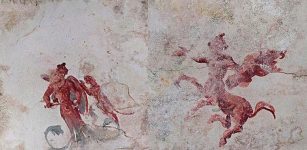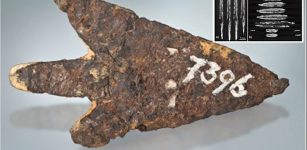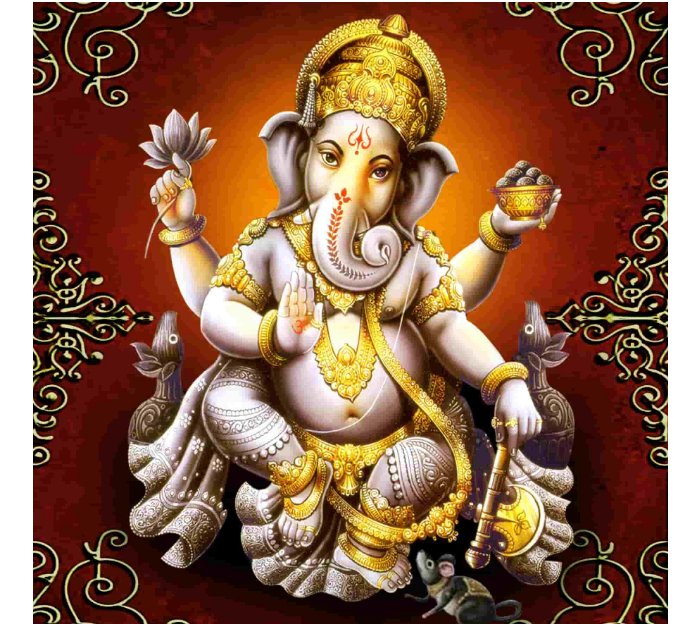Ganesha: Elephant-Headed God Of Knowledge, Learning, Literature And Scribe Of The Mahabharata
A. Sutherland - AncientPages.com - It is commonly believed that the Elephant God, Ganesha (Ganesh, in Hindi word) means success and wealth; therefore people place a statue or a figurine of the Ganesha, in his store, or another place of their business.
Ganesha is one of the best-known and loved deities in the Hindu pantheon of gods and indeed is the most recognized of the Hindu gods outside of India.
Lord Ganesha. Image credit: Jayananda sagar - CC BY-SA 3.0
He is the Lord of Good Fortune, the Lord of Beginnings, and the Remover of Obstacles and evils people meet in their lives, but he can also place obstacles in the path of those who need to be checked. He is also considered the destroyer of pride, selfishness, vanity.
Ganesha protects homes and cars. People often place a Ganesha statue or medallion on the front dash of their cars. Ganesha is also associated with learning and study, scribes, schools, and wisdom.
It is he who transcribed the Mahabharata while the poet Vyasa recited it. The elephant-headed son of Parvati and Shiva, Ganesha (Ganapati) with a bulky belly and four hands, is the subject of many myths.
One myth in the Shiva Purana explains his elephant-head, it is said that he was created by his mother Parvati ( daughter of the mountain) using earth, which she molded into the shape of a boy.
One day, while Shiva was away, Parvati wanted to take a bath but there was no one to guard the door. So she formed a little boy from clay and breathed life into him. She instructed him to guard the entrance to her bathroom, while she bathed.
Ganesha - the God of Powers, Abilities, wisdom, knowledge, intelligence, arts, and Skill Ganesha possesses the traditional bodily attributes of the Hindu gods, which includes superhuman strength, superhuman stamina, endurance, resistance to harm, and enchanted longevity. Image credit: Pradeep Kumar Sharma - CC BY-SA 4.0
Unexpectedly Shiva returned and was furious that the boy at the door would not let him in to see his wife. In his rage, he cut off the boy’s head. Parvati came rushing out and was horrified by what Shiva had done. She told him that this was their son. Shiva ordered a new head to be found for the boy and, as the first animal available was an elephant, so Ganesha gained a new head and became the most unique of the Hindu gods.
The boy was short and fat with a red face, but in some deeper sense, he was very beautiful. He was named Ganesh, “Lord of his father’s ganas” (“hosts”) and a small mouse often showed on his depictions, became his vahana (vehicle) to ride on.
Ganesha is portrayed as standing, sitting, dancing, or crawling as a child, or even sitting on his mother's knee.
His image is found everywhere, in many different forms. Ganesh is widely worshiped in all parts of India, regardless of people’s spiritual affiliations and his characteristics and the attributes that have evolved over the centuries of Indian history.
Written by – A. Sutherland AncientPages.com Staff Writer
Copyright © AncientPages.com All rights reserved. This material may not be published, broadcast, rewritten or redistributed in whole or part without the express written permission of AncientPages.com
Expand for referencesMore From Ancient Pages
-
 Bizarre Parthian Tomb Sheds Light On Ancient Life In Isfahan, Central Iran
Archaeology | Jun 25, 2020
Bizarre Parthian Tomb Sheds Light On Ancient Life In Isfahan, Central Iran
Archaeology | Jun 25, 2020 -
 Major Discovery Reveals Neanderthals In Italy Engaged In Plant Food Processing
Evolution | Jun 29, 2023
Major Discovery Reveals Neanderthals In Italy Engaged In Plant Food Processing
Evolution | Jun 29, 2023 -
 On This Day In History: Charlemagne King Of The Franks And Emperor Of The Holy Roman Empire Born – On April 2, 742
News | Apr 2, 2017
On This Day In History: Charlemagne King Of The Franks And Emperor Of The Holy Roman Empire Born – On April 2, 742
News | Apr 2, 2017 -
 Sphinx Room Discovered At Emperor Nero’s Famed Domus Aurea (Golden House)
Archaeology | May 9, 2019
Sphinx Room Discovered At Emperor Nero’s Famed Domus Aurea (Golden House)
Archaeology | May 9, 2019 -
 Three Unusual Celestial Journeys And The Chosen Ones Initiated Into The Secrets Of The Gods
Ancient Mysteries | Jul 26, 2021
Three Unusual Celestial Journeys And The Chosen Ones Initiated Into The Secrets Of The Gods
Ancient Mysteries | Jul 26, 2021 -
 New System Will Give Stone Age Skeletons And Mummies Unique Names
Archaeology | Oct 2, 2024
New System Will Give Stone Age Skeletons And Mummies Unique Names
Archaeology | Oct 2, 2024 -
 6,000-Year-Old Bizarre, Mouthless ‘Alien’ Mask Unearthed In “The Salt Pit” Settlement In Northeast Bulgaria
Archaeology | Nov 20, 2020
6,000-Year-Old Bizarre, Mouthless ‘Alien’ Mask Unearthed In “The Salt Pit” Settlement In Northeast Bulgaria
Archaeology | Nov 20, 2020 -
 Ancient DNA Analysis Shows How The Rise And Fall Of The Roman Empire Shifted Populations In The Balkans
DNA | Dec 8, 2023
Ancient DNA Analysis Shows How The Rise And Fall Of The Roman Empire Shifted Populations In The Balkans
DNA | Dec 8, 2023 -
 What Can Languages And Grammar Reveal About Our Ancient History?
Archaeology | Aug 20, 2021
What Can Languages And Grammar Reveal About Our Ancient History?
Archaeology | Aug 20, 2021 -
 Rare Stone Showing Ancient Rome’s City Limits – Accidentally Found
Archaeology | Jul 18, 2021
Rare Stone Showing Ancient Rome’s City Limits – Accidentally Found
Archaeology | Jul 18, 2021 -
 Mysterious Ancient Female Society Discovered – What Happened To All The Men? Archaeologists Wonder
Featured Stories | Oct 3, 2024
Mysterious Ancient Female Society Discovered – What Happened To All The Men? Archaeologists Wonder
Featured Stories | Oct 3, 2024 -
 The Real Paleo Diet: New Archaeological Evidence Changes What We Thought About How Ancient Humans Prepared Food
Featured Stories | Nov 28, 2022
The Real Paleo Diet: New Archaeological Evidence Changes What We Thought About How Ancient Humans Prepared Food
Featured Stories | Nov 28, 2022 -
 Archaeologists Discover Gloucestershire’s Hidden Treasures
Archaeology | May 14, 2024
Archaeologists Discover Gloucestershire’s Hidden Treasures
Archaeology | May 14, 2024 -
 Oldest Evidence To Date: 80,000-Year-Old Stone Blades Of Homo Sapiens Found In Jebel Faya, Arabia
Archaeology | Feb 19, 2025
Oldest Evidence To Date: 80,000-Year-Old Stone Blades Of Homo Sapiens Found In Jebel Faya, Arabia
Archaeology | Feb 19, 2025 -
 Mysterious Figurine Of Mythical Individual Dates Back To Egypt’s Naqada Culture 4400–3000 BC
Featured Stories | Sep 25, 2016
Mysterious Figurine Of Mythical Individual Dates Back To Egypt’s Naqada Culture 4400–3000 BC
Featured Stories | Sep 25, 2016 -
 Sir Francis Walsingham: Spymaster, Politician And Trusted Adviser To Queen Elizabeth I
Featured Stories | Nov 25, 2019
Sir Francis Walsingham: Spymaster, Politician And Trusted Adviser To Queen Elizabeth I
Featured Stories | Nov 25, 2019 -
 Startling Discovery Of Nubian Levallois Technology In Shukbah Cave Re-Writes Ancient History Of Neanderthals And Homo Sapiens
Archaeology | Feb 24, 2021
Startling Discovery Of Nubian Levallois Technology In Shukbah Cave Re-Writes Ancient History Of Neanderthals And Homo Sapiens
Archaeology | Feb 24, 2021 -
 Mysterious And Abnormally Large Burials Found Near The Black Fortress In Armenia – Who Was Buried There?
Featured Stories | Jan 2, 2025
Mysterious And Abnormally Large Burials Found Near The Black Fortress In Armenia – Who Was Buried There?
Featured Stories | Jan 2, 2025 -
 Historian Suggests Jack The Ripper Fled To Australia Where He Met His End
Archaeology | Sep 10, 2016
Historian Suggests Jack The Ripper Fled To Australia Where He Met His End
Archaeology | Sep 10, 2016 -
 Arrowhead Made Of Meteoritic Iron From The Late Bronze Age Settlement Of Mörigen, Switzerland – Examined
Archaeology | Aug 1, 2023
Arrowhead Made Of Meteoritic Iron From The Late Bronze Age Settlement Of Mörigen, Switzerland – Examined
Archaeology | Aug 1, 2023


